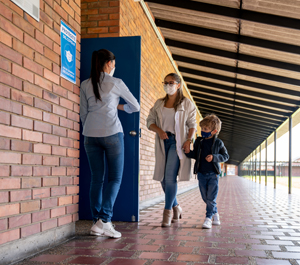Your Communication Plan Is Key to the New School Year

Another school year is fast approaching, and you may wonder how you can help your child have a smooth start. Getting to know your child’s teacher is a good place to begin.
“Communication is key,” says Jennifer Ciran-Debban, MA, LMHC. A family education partner at Grant Wood Area Education Agency in Cedar Rapids, Iowa, she helps parents to request educational accommodations for their children.
Set up regular communication with teachers and other staff members early in the school year, she suggests, to address any concerns instead of waiting until there is a crisis. Share information from the previous school year and be sure to talk about your child’s strengths and successes.
Requesting academic accommodations
When requesting an evaluation or accommodations for your child, make your request in writing. Include all teachers and support staff, including the school principal, who work with your child.
“It should clearly state the request, list objectively stated reasons for the request, and politely indicate a reasonable timeframe in which the parent expects to hear back in writing,” says Karen Thompson, executive director of Iowa’s Ask Resource Center, one of nearly one hundred Parent Information and Training Centers in the United States. Reasonable is usually around ten days. That doesn’t mean the meeting will occur in ten days. It means you should hear back in writing within that timeframe with a clear plan to schedule a meeting with all parties.”
August is a busy time of year for teachers and other school staff, and she says parents should be patient. School administrators should respond promptly, and parents should ask for an evaluation or a meeting in the first part of September.
Revisit the information with your child’s education team during the first meeting, and be sure everyone involved has the information they need to begin informal planning ahead of time, she says. If your child already has a 504 or IEP, and you want to make changes to it, make sure that you do so by communicating in writing with your child’s teacher as early in the school year as possible.
It is important to ask your child’s teachers if they are currently making classroom accommodations, and ask them to document those accommodations in your child’s 504 plan or IEP says Ms. Ciran-Debban.
“Teachers are great about accommodating on the spot, but we don’t often think about getting those documented,” she says.
Talk with your child, especially if they are in middle or high school, to get their input on what accommodations they think will be helpful. This is also important, because it helps your child learn to self-advocate. When you bring your child into the conversation, you reduce the likelihood of including accommodations they won’t use.
Returning to in-person learning
This school year will be different because many students will return to in-person learning, and that may take a little getting used to. Ms. Ciran-Debban suggests that you share with teachers anything that worked well while your child was learning from home. She advises setting aside time for your child to visit their classroom, if possible, meet teachers, and get used to the idea of being back in school. This will help reduce any anxiety your child may have about the beginning of the school year.
“This year will be particularly challenging as we work on supporting kids with 504s and IEPs coming out of the pandemic. That makes it all the more important to start planning early,” says Ms. Thompson. “One parent we work with is already orienting her child with ADHD to his new classroom using pictures and visits to school. It’s okay to be creative in your approach with your team about those things.”
Especially for children with ADHD, the adjustment period may take longer and there may be a greater learning gap, so talking with your child’s teacher is critical.
“Communication plans between families and educators are essential because consistency for the student is key,” says Ms. Thompson.
Learn more:
- Tips for Talking to Teachers About ADHD
- Strategies to Help with School Success: A Toolkit for Parents of Children with ADHD
- How to Write a Teacher Letter In ADHD Newsstand | In Attention magazine
- Pro Tips for School Team Meetings
- What Should Parents Look for in a Good Evaluation for ADHD?
Join the conversation: How do you open the lines of communication with your child’s teacher?
